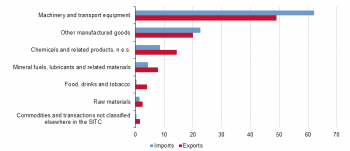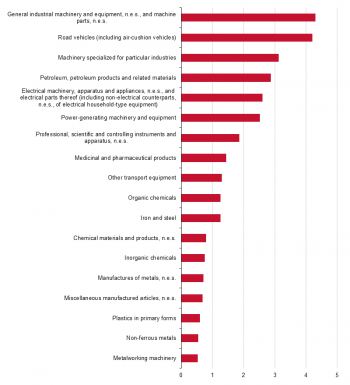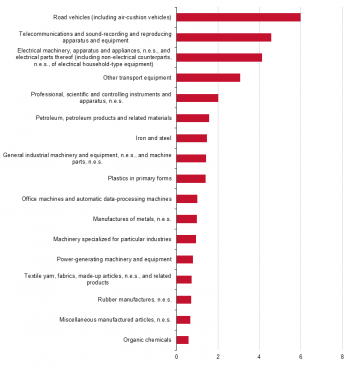Archive:South Korea-EU - trade in goods - data 2015
EU-South Korea trade relations boosted by the recent free trade agreement
Statistics in focus 1/2015; Author: Mushtaq Hussain
ISSN:2314-9647 Catalogue number:KS-SF-15-001-EN-N
This statistical article has been archived
This article analyses European Union (EU) trade in goods with South Korea. It provides information about the impact on trade in goods of the Free Trade Agreement (FTA) with the Republic of Korea that entered into force in July 2011, as the first of a new generation of FTAs signed by the EU (see chapter context).
The Free Trade Agreement between the EU and the Republic of Korea (EU-South Korea FTA) was launched in 2007 as part of the ‘Global Europe’ initiative. These agreements, based on solid economic criteria, represent a stepping stone for future liberalisation as they also tackle issues which are not ready for multilateral discussion and go beyond the market opening that can be achieved in the context of the World Trade Organization (WTO).
Accordingly, the EU-South Korea FTA is the most comprehensive free trade agreement ever negotiated by the EU. Import duties are eliminated on nearly all products and there is a far reaching liberalisation of trade in services covering all modes of supply. It includes provisions on investments both in services and industrial sectors, strong disciplines in important areas such as the protection of intellectual property (including geographical indications), public procurement, competition rules, transparency of regulation and sustainable development. Specific commitments to eliminate and to prevent non-tariff obstacles to trade have been agreed in sectors such as consumer electronics [1], automobiles, pharmaceutical products and medical devices and chemicals.

(trade value in billion EUR)
Source: Eurostat (ext_lt_introle)
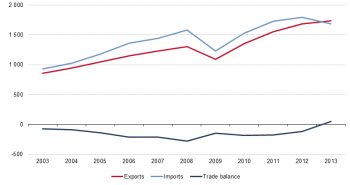
(trade value in billion EUR)
Source: Eurostat (ext_lt_introle)
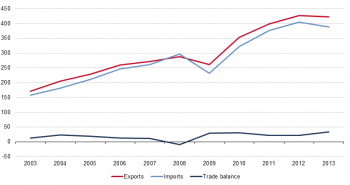
(trade value in billion EUR)
Source: Eurostat (ext_lt_introle)

(%)
Source: Eurostat (ext_lt_introle)

(%)
Source: Eurostat (ext_lt_introle)
Main statistical findings
EU and South Korea in world trade
The EU is the world’s largest exporter of goods and services, and is itself the biggest export market for around 80 countries. Trade is an important indicator of the EU's prosperity and place in the world. In 2012 the EU recorded the world’s highest value for total exports of goods (EUR 1 683.1 billion). The EU-28 had also ranked first among world importers since 2008. However, in 2012 the imports of the United States (EUR 1 816.5 billion) were slightly higher than those of the EU (EUR 1 798.6 billion). Thus, in 2012, the EU-28 recorded a deficit of EUR 115.5 billion, the third highest deficit behind the United States and India (see Figure 1).
Over the last couple of decades, South Korea has developed into one of Asia’s leading economies. In 2012 it ranked fifth in the list of global exporters of goods (with a value of EUR 426.4 billion) behind the EU, the United States, China and Japan. South Korea also ranks fifth among global importers, with almost the same value (EUR 404.4 billion). South Korea’s trade surplus in 2012 therefore stood at EUR 22.0 billion.
Both the EU and South Korea experienced a similar evolution of trade during the years 2003 – 2013. After a steady growth during the period 2003 – 2008 both suffered a decline in 2009, as a consequence of the global financial and economic crisis. However, exports as well as imports gained in momentum in the following years. In 2013, in the EU, imports fell again compared with 2012, while exports continued to grow, although at a reduced speed. As a result, in 2013 the EU trade balance was positive for the first time since the beginning of the series (2003). The lowest trade deficit was registered in 2003 (EUR 73.4 billion), while the highest was recorded in 2008 (EUR 276.1 billion) (see Figure 2).
In South Korea, in contrast, both exports and imports declined in value in 2013, although South Korea achieved its highest trade surplus (EUR 33.2 billion) during that year. Another high trade surplus had been achieved in 2009 (EUR 29.0 billion) despite the lower imports and exports. The highest export and import values were recorded in 2012 (EUR 426.4 billion and EUR 404.4 billion respectively). In contrast with the EU, South Korea’s trade balance has been positive throughout the period observed, except for 2008, when there was a EUR 9.0 billion deficit (see Figure 3).
The structures of international trade of the EU and South Korea are quite similar. Manufactured goods (which include chemicals, machinery and transport equipment, and other manufactured goods) account for about 80% of total exports. The biggest share originates from machinery and vehicles, which make up 40.8% of total EU exports. For South Korea the share is even higher at 54.6%. Chemical products and other manufactured products account for 16.7% and 22.1% respectively of total EU exports. For South Korea the respective shares are 11.8% and 21.3%.
Although manufactured goods constituted more than 50% of imports of both the EU and South Korea, the biggest imported item is mineral fuels, lubricants and related materials, at 29.6% of the EU’s total imports compared with 35% for South Korea. In the EU, machinery and vehicles and chemical products accounted for smaller shares, 25.8 % and 9.4 % respectively. It should be noted that the share of primary products (raw materials: food, drink and tobacco and mineral fuels) has increased in recent years, up to 39.7 % in 2013, while the share of manufactured goods has declined. For South Korea, machinery and vehicles accounted for 26.1 %, other manufactured goods for 18.2 % and chemical products for 9.1 % of total imports. The share of raw materials (6.9 %) and food, drinks and tobacco (4.4 %) were also not negligible (see Figure 4 and 5).
EU trade in goods with South Korea
South Korea is the EU’s tenth largest trading partner, while the EU is South Korea’s fourth export destination (after China, Japan and the United States). The importance of the relationship has been recognised with the establishment of a new institutional framework — the already mentioned FTA — to facilitate cooperation.
After slowing down in 2009 due to the global financial and economic crisis, trade flows between the EU and South Korea started to increase again in 2010. Despite the faster growth of EU-28 exports to South Korea, the value of imports from South Korean was continuously higher by a considerable margin. Hence the EU-28 trade balance with South Korea was consistently negative until 2012 (see Figure 6).
For the period observed, the EU-28’s highest trade deficit was recorded in 2006 (EUR 18.1 billion). In recent years the gap between the value of imports from and exports to South Korea has been narrowing. Between 2006 and 2013 the value of EU-28 exports to South Korea increased while EU-28 imports from South Korea decreased. As a result, in 2013 exports exceeded imports for the first time since the beginning of the series (2003). In 2013 the EU-28 recorded its highest exports (EUR 39.9 billion) and reached a trade surplus of EUR 4.1 billion. In the period observed EU exports to South Korea enjoyed an annual average growth rate of 9.8 %.
Since the FTA entered into force in July 2011, EU goods exports to South Korea have increased considerably. The total value of exported goods from the EU-28 to South Korea was 42.7 % higher in 2013 than in 2010. The value of imports remained stable.
In 2013 machinery and transport equipment were EU’s most popular global exports and, at 49.0 % of the total, they were also by far the most important exports to South Korea. Other manufactured goods accounted for 20.0 % and chemical products for 14.4 %. Thus, manufactured products made up the biggest share of EU exports to South Korea. Primary products followed with smaller shares: energy products accounted for 7.8 %, food, drinks and tobacco for 4.1 % and raw materials for 2.5 % (see Figure 7).
The product group machinery and vehicles made up the biggest share of EU imports from South Korea (62.1 %). Other manufactured goods and chemical products accounted for smaller shares (22.6 % and 8.6 % respectively). The pattern was quite similar to that of EU exports. The combined share of primary products made up 6.3 % of all EU imports.
EU imports of machinery and transport equipment and other manufactured goods from South Korea recorded higher values than exports resulting in trade deficits of 13.1 % and 2.7 % respectively. All other products recorded trade surpluses.
Following the entry into force of the FTA with South Korea, EU exports of liberalised products to South Korea, such as consumer electronics, automobiles, pharmaceutical products and medical devices and chemicals, have increased. The trade between the EU and South Korea is dominated by power/non-electrical machinery, chemicals, transport equipment, optical and photo equipment and base metals.
Major EU exports to South Korea were high-tech manufactured products like semiconductors, machinery, automobiles, ships, LCD and wireless communication devices.
EU imports from South Korea consisted mainly of textiles, consumer electronics and cars, oil, semiconductors and natural gas. Figures 8 and 9 display the trade between the EU and South Korea at a more detailed level. Products at SITC (level 2) with trade values of over EUR 0.5 billion are shown.
This development in the trade relationship between the EU and South Korea results from the fact that machinery and appliances represent the sector with the largest reduction in duties. 70 % of those duties were removed as of the entry into force of the FTA. The chemical sector was the second largest beneficiary and will see a duties relief of EUR 175 million on top of EUR 143 million which were already removed. Other industrial sectors enjoyed lower absolute gains, but benefitted from considerable duty reliefs from the outset: textile exports saw 93 % of duties wiped away immediately, glass 85 %, leather and fur 84 %, footwear 95 %, iron and steel 93 % and optical instruments 91 %. [2]
Data sources and availability
The source for the statistics in this publication is essentially Eurostat. Data are collected by the competent national authorities of the EU Member States and compiled according to a harmonised methodology established by EU regulations before transmission to Eurostat. The statistical information is mainly provided by the traders on the basis of Customs (extra-EU) and Intrastat (intra-EU) declarations.
Methodology In the methodology applied for statistics on the trade of goods, extra-EU trade statistics (trade between EU Member States and non-member countries) do not record exchanges involving goods in transit, placed in a customs warehouse or given temporary admission (for trade fairs, temporary exhibitions, tests, etc.). This is known as ‘special trade’. The partner is the country of final destination of the goods for exports and the country of origin for imports.
Product classification
- Combined Nomenclature (CN) — Harmonised System (HS)
- For extra- and intra-EU trade purposes goods are classified according to the Combined Nomenclature (CN). This classification is based on the Harmonised Commodity Description and Coding System (HS) managed by the World Customs Organisation (WCO). The HS uses a six digit numerical code for the coding of products and the Combined Nomenclature is further breaking down the coding into a eighth digit level according to EU needs.
- The CN is extended with some alphanumeric codes that are used to identify confidential or adjusted data and trade for which a breakdown of the results at a detailed level of product classification is not possible.
- The first six digit codes of CN coincide with the HS.
- Standard international trade classification (SITC)
- SITC is a product classification of the United Nations (UN) used for external trade statistics (export and Import values and volumes of goods), allowing for international comparisons of commodities and manufactured goods.
- The main categories are:
- food, drinks and tobacco (Sections 0 and 1 — including live animals);
- raw materials (Sections 2 and 4);
- energy products/ Mineral fuels, lubricants and related materials (Section 3);
- chemicals (Section 5);
- machinery and transport equipment (Section 7);
- other manufactured goods (Sections 6 and 8).
A full description is available from Eurostat’s classification server RAMON.
Context
The EU-South Korea Free Trade Agreement entered into force in July 2011 and is the first completed agreement in a new generation of FTAs launched by the EU in 2007. It is also the EU’s first trade deal with an Asian country. This new generation of agreements goes further than previous agreements in lifting trade barriers. The Agreement eliminates tariffs for industrial and agricultural goods in a progressive, step-by-step approach. Only a limited number of agricultural products are excluded from tariff elimination. In addition to eliminating duties on nearly all trade in goods, the agreement addresses non-tariff barriers to trade. It also includes provisions on issues ranging from services and investments, competition, government procurement, intellectual property rights, transparency in regulation to sustainable development. [3]
The objectives of this agreement are:
- to liberalise and facilitate trade in goods between the parties, in conformity with Article XXIV of the General Agreement on Tariffs and Trade 1994 (GATT1994);
- to liberalise trade in services and investment between the parties, in conformity with Article V of the General Agreement on Trade in Services ( GATS);
- to promote competition in their economies, particularly as it relates to economic relations between the parties;
- to further liberalise, on a mutual basis, the government procurement markets of the parties;
- to adequately and effectively protect intellectual property rights;
- to contribute, by removing barriers to trade and by developing an environment conducive to increased investment flows, to the harmonious development and expansion of world trade;
- to commit, in the recognition that sustainable development is an overarching objective, to the development of international trade in such a way as to contribute to the objective of sustainable development and strive to ensure that this objective is integrated and reflected at every level of the parties’ trade relationship; and
- to promote foreign direct investment without lowering or reducing environmental, labour or occupational health and safety standards in the application and enforcement of environmental and labour laws of the parties. [4]
See also
- International trade in goods
- International trade in services
- International trade statistics introduced
- Extra-EU trade in goods
- The EU in the world - international trade
Further Eurostat information
Publications
- International trade and foreign direct investment — pocketbook — edition 2013
- External trade by enterprise characteristics
- International trade, see publications — Comext DVD: Intra- and extra-European Union trade — monthly data — combined nomenclature
- The EU in the world 2014
- The EU in the world 2013
- The European Union and the Republic of Korea — 2012
- EU-South Korea Free Trade Agreement: a quick reading guide, October 2010
Main tables
- International trade, see:
- International trade data (t_ext)
- International trade long-term indicators (t_ext_lti)
- International trade short-term indicators (t_ext_sti)
Database
- International trade, see:
- International trade data (ext)
- International trade long-term indicators (ext_lti)
- International trade short-term indicators (ext_sti)
- International trade detailed data (detail)
Dedicated section
Methodology / Metadata
- EU-International trade data — Metadata page (ESMS metadata file — ext_esms)
Source data for figures (MS Excel)
Other information
External links
- Free Trade Agreement with the Republic of Korea
- European Commission — Globalisation
- European Commission — Trade
Notes
- ↑ EU-South Korea Free Trade Agreement: a quick reading guide, October 2010.
- ↑ http://trade.ec.europa.eu/doclib/docs/2011/october/tradoc_148303.pdf
- ↑ http://europa.eu/rapid/press-release_IP-12-708_en.htm.
- ↑ Free Trade Agreement with the Republic of Korea.

